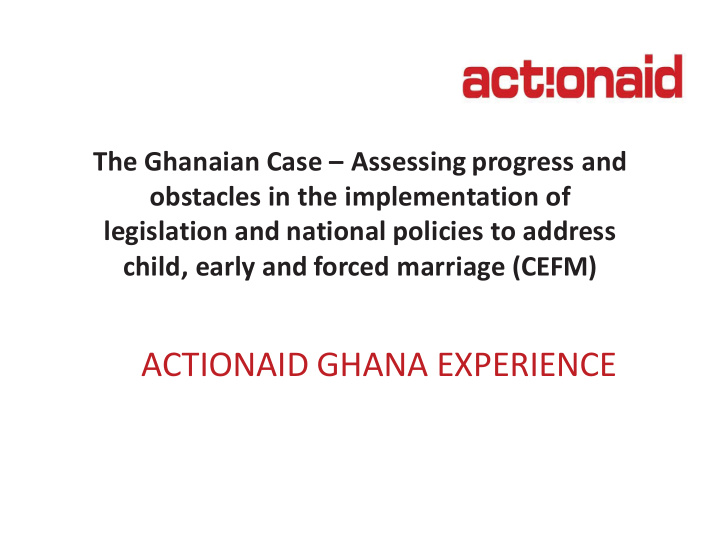



The Ghanaian Case – Assessing progress and obstacles in the implementation of legislation and national policies to address child, early and forced marriage (CEFM) ACTIONAID GHANA EXPERIENCE
Outline • Introduction to Child marriage • ActionAid experience in Ghana • Challenges with Policies and law enforcement in Ghana • Collaboration • Recommendation
Introduction Child marriage is a formal or informal union in which at least one of the parties is a child. In Ghana, the Children’s Act, 1998 (Act 560) defines a child as a person below the age of eighteen years. The Act also sets the minimum age for marriage at eighteen.
Introduction The practice of Child marriage in Ghana is real and cuts across all the ten regions of Ghana. It is pervasive and if not checked can post a developmental threat to governments
Con’t AU Campaign to End Child Marriage project initiated in 2014 to accelerate the fight against Child marriage is a wake up call to all African nations including Ghana to double their effort at combating the menace of child marriage.
ACTIONAID EXPERIENCE WITH CHILD MARRIAGE IN GHANA ActionAid Ghana identified child marriage as a human rights violation and a developmental challenge since 2010 through its work with community volunteers called COMBAT.
Con’t 57 Community based anti-violence teams(COMBAT) were formed in 3 districts of the Upper West Region. It was these community volunteers who identified marriage by abduction as one of the commoners forms of child marriage in the area.
Marriage by abduction as a form of child marriage This practice involves the abduction of a girl usual below the age of 18 years for marriage. By tradition, the relatives of the girl would later be informed by the man’s relative about the where about of the girl and then initiate processes to pay the bride price.
This is how it is done sometimes
Socio-cultural practices Other forms of socio-cultural practice that perpetuate child marriage in the six regions that ActionAid Ghana works include. � Teenage pregnancy leading to force marriage � Exchange marriage � Bethrodal(almost extinct) � Marriage by elopement. � Adoption.
SUCCESS Through ActionAid work with COMBAT 126 school girls from 57 communities in Upper West Region were rescued from child marriage and sent back to school to continue their education in 2014. Even though few of them have gone back to marry, majority of them are in Junior high school and some have enrolled into secondary and technical schools across the region.
Challenges with Law enforcement � Difficulty in prosecuting Child marriage cases due to the challenge with ascertaining the rightful age of the child. In most rural communities parents do not register the birth of their children. � The use of multiple identity cards with conflicting information about the date of birth of a child makes it more difficult to rely on other IDs as an alternative to birth certificate. E.g Voter ID, National insurance ID etc . � Interference by Prominent people in society.
Con’t � Domestic Violence and Victims Support Unit (DOVVSU) of Ghana police service and Commission for Human Rights and Administrative Justice(CHRAJ) are located at the Metropolitan, Municipal and District capitals making it difficult for remote and distant communities to access justice.
COLLABORATION ActionAid is currently collaborating with UNICEF to implement end child marriage project in 4 regions in Ghana namely: � Upper East � Upper West � Brong Ahafo � Greater Accra
GOAL The overall goal is to contribute to the elimination of child marriage in Ghana.
Con’t Two Objectives to achieve under the project include: • To reduce socio-cultural practices that facilitate the incidence of child marriage in Target districts. • To build the capacity of girls aged 12-17 years to resist child marriage and focus on their education.
Strategies � Awareness raising in 120 communities � Advocacy and campaign for the elimination of socio-cultural practices that promote Child marriage. � Capacity building of community structures such as COMBAT,PTA and Girls Clubs to champion the fight against all forms of Child marriage.
TARGET BENEFICIARIES � Direct beneficiaries would be 3,600 girls below the age of 18 years drawn mostly from girls clubs. � Indirect beneficiaries would include over 110,000 people from the 120 communities.
State Actors State actors in this project include: � MGCSP � CHRAJ � DOVVSU � GES
Recommendations � Registration of births must be made compulsory, accessible and affordable to all. � It is imperative to build capacity of community structures to respond to issues of child marriage at the community level. � Strengthen state institutions to effectively enforce laws that protect and promote the rights of children .
Thanks
Recommend
More recommend